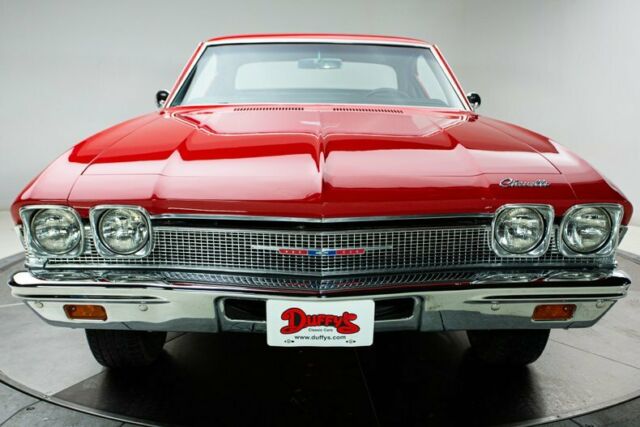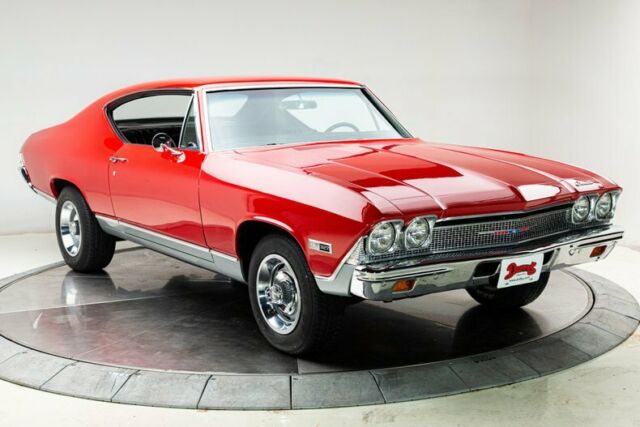1968 Chevrolet Chevelle 327 V8 L79 Coupe Matador Red
| Make: | Chevrolet |
| Model: | Chevelle |
| Type: | Coupe |
| Trim: | -- |
| Year: | 1968 |
| VIN: | 136378B234635 |
| Color: | Red |
| Engine: | 327 V8 L79 |
| Fuel: | Gasoline |
| Transmission: | -- |
| Drive type: | -- |
| Interior color: | Black |
| Vehicle Title: | Clear |
| Item location: | Local pick-up only |
1968 Chevrolet Chevelle -- Additional Info:
1968 Chevrolet Chevelle Can you spell L79? Nineteen sixty-eight was a great year to be a Chevy fan. The Camaro had just experienced a successful inaugural model year and was due for more refinements. The Chevy II was all-new, now with room for a big block. The Corvette also had been completely redesigned and was totally bitchin'. The Chevelle made it a troika - a new semi-fastback design with more-pronounced coke-bottle styling looked like it was carved from one piece.... In engine news, the 350 from the Camaro lost its exclusive status when it was made standard for the Nova SS (with the 396 as an option for the first time), and the L78 396 received an available L89 aluminum head option for the Camaro and Chevelle. But hidden in that mix was a small block that once gave Grumpy Jenkins the firepower to beat Chrysler's King Kong HEMI. That motor was the L79 327. However, by 1968, the muscle car landscape had evolved such that big blocks were ruling the roost. For example, the ever-popular GTO made do with 400 cid, and Plymouth and Dodge had a massive 440 that they introduced the year before. Prospective buyers were clamoring for torque and image, and the L79 had neither because it wasn't a 396 and it wasn't available in either the Chevelle or Nova Super Sports. The most well-known feature of the L79 engine was its high-performance hydraulic camshaft, the first of its kind. The L79 used a wide bore and a short, efficient stroke. The four-inch bore allowed for large valves, and a stroke of only 3.25 inches meant the pistons did not have far to go to deliver massive power. Details The four-barrel V8 L79 engine had a top speed of 120 mph. It featured an 11:1 compression ratio with domed pistons made of forged aluminum and a small-journal crankshaft. The L79 had a displacement of 326.721 cubic inches. It had a maximum horsepower of 350 hp at 5800 rpm, and a maximum torque of 360 foot-pounds at 3600 rpm. Standard horsepower at 4400 rpm was 250 hp. Production Between 1965 and 1968 14,151 L79s were included in the Chevelle models, with none being produced in 1966. Features Strong Detailed Numbers Matching L79 327 with 350 HP Newer replacement Edelbrock 1406 4 BBL Carb On Original Cast Iron intake Numbers matching Muncie 4 speed 10 Bolt open rear end with 3:23 Ratio Gears Power Assist Steering Standard Brakes all around Newer Tuxedo Black Strato Bucket Seat Interior Full factory instrumentation with aftermarket Tach Flo Thru Ventilation with Adjustable Dash Vents Brushed Aluminum 3 Spoke steering wheel Aftermarket Bowtie AM/FM CD/MP3 Stereo in the dash Full length center console with storage compartment Safety Guard Black GM Seat Belts High Performance Custom Aluminum Radiator Chrome Bow Tie driver's side mirror Performance tuned dual exhaust with Chrome tips Factory type GM Rallye Wheels with Trim Rings and Center Caps Set of Matched 215/70/15 and 255/60/15 Blackwall Radials Finished in Mirror Gloss Matador Red not the original color























